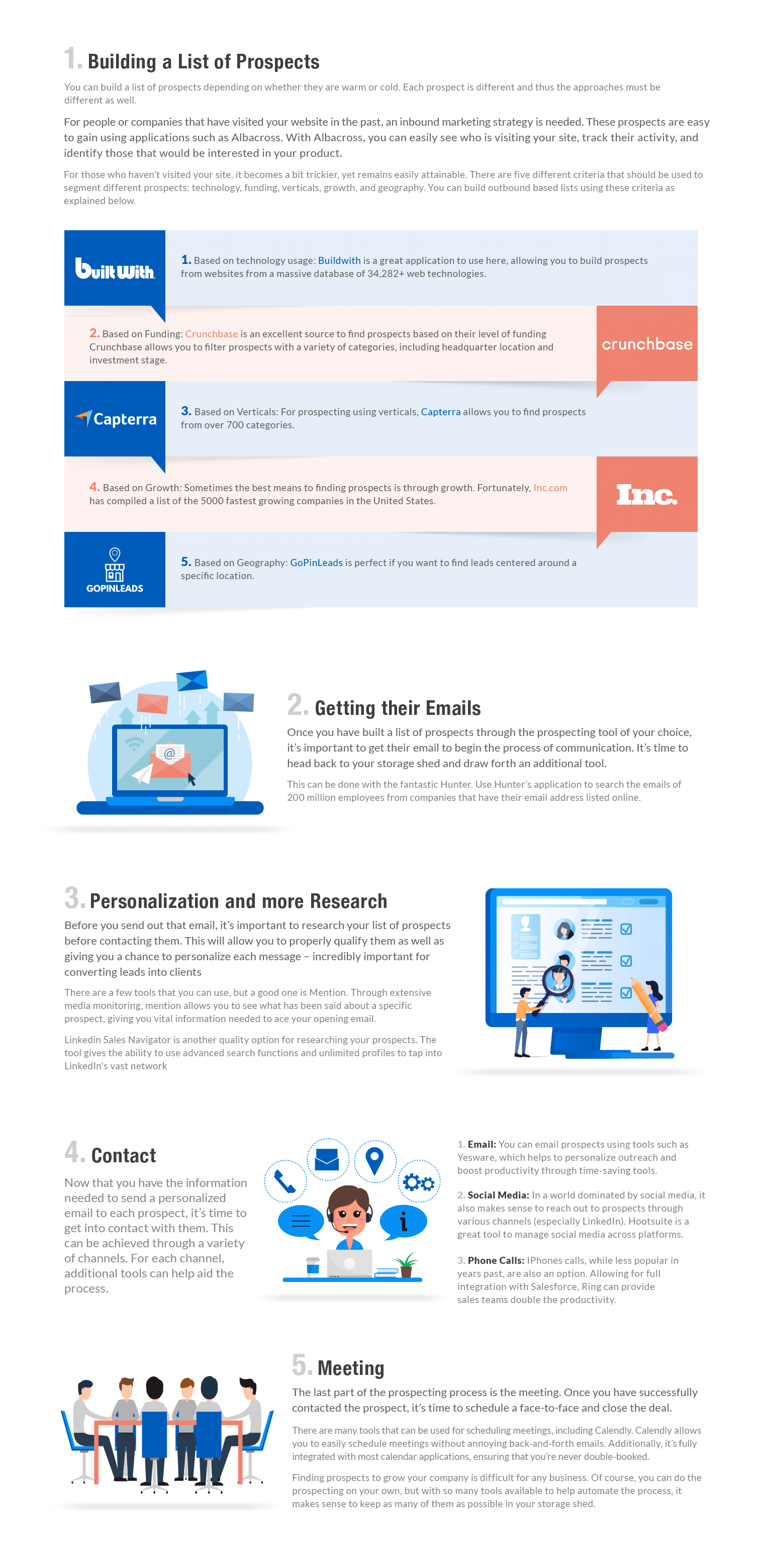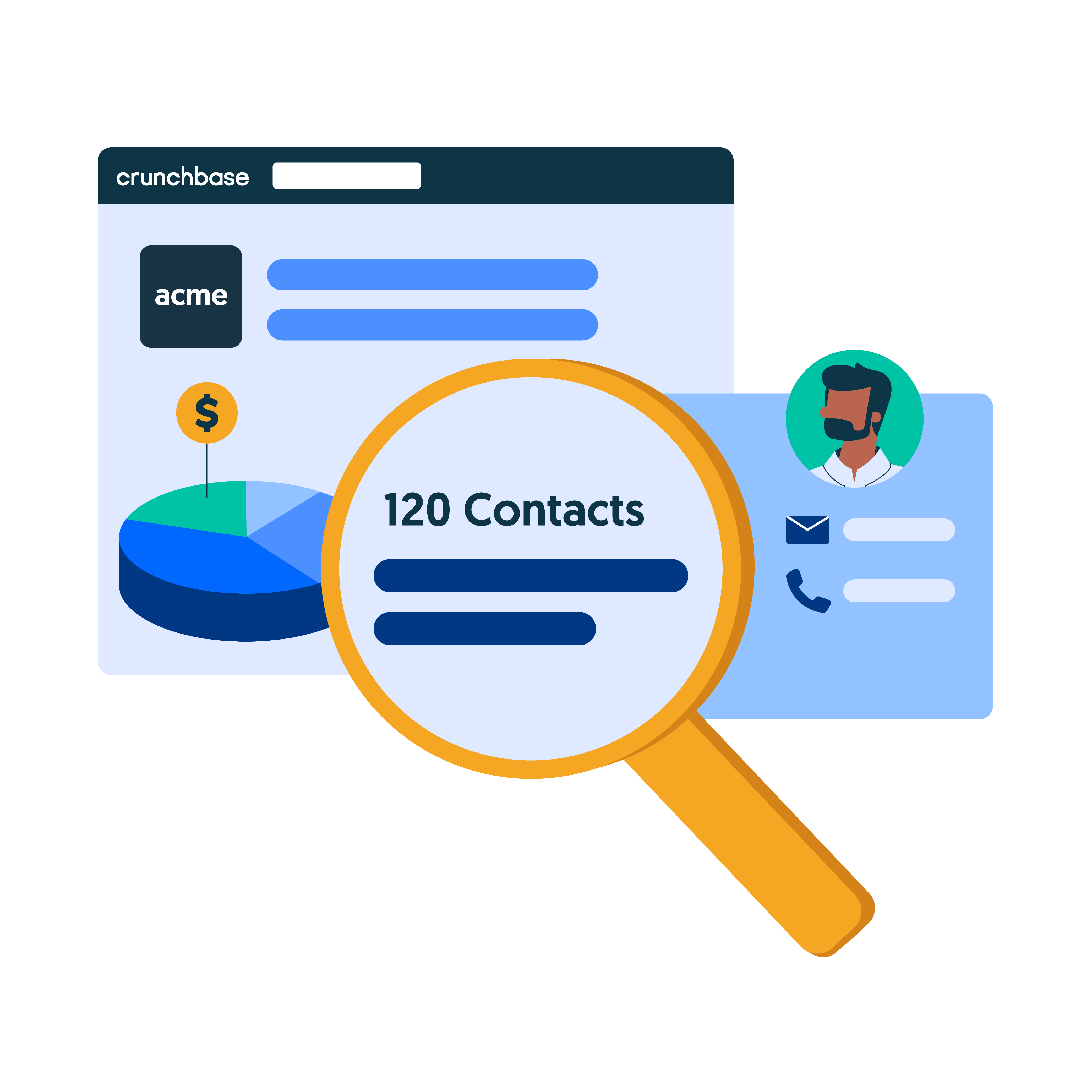With 50 percent of companies failing within five years, growth is often a question of survival. Therefore, it’s important that growth strategies are as efficient as possible. It’s challenging to find a quality list of prospects. You don’t want vital resources wasted on prospects that don’t end up going anywhere. In order to maximize converting prospects into new customers, you need to have a solid plan as well as a great set of sales prospecting tools.
Prospecting Tools for Sales Broken Down By Step
In this piece, you’ll find prospecting tools to:
- Build a list of prospects
- Identify emails
- Help personalize and research
- Gather contact information
- Set up meetings
In order to simplify the process, you can break down prospecting into five broad steps. This article covers the most important tools to help you with each step. By storing a combination of these in your growth storage shed, you will find obtaining prospects to be a much more attainable goal.
1. Sales Prospecting Tools to Help Build a List of Prospects
You can build a list of prospects depending on whether they are warm or cold. Each prospect is different and thus the approaches must be different as well.
For people or companies that have visited your website in the past, an inbound marketing strategy is needed. These prospects are easy to gain using applications such as Albacross. With Albacross, you can easily see who is visiting your site, track their activity, and identify those that would be interested in your product.
For those who haven’t visited your site, it becomes a bit trickier, yet remains easily attainable. There are five different criteria that should be used to segment different prospects: technology, funding, verticals, growth, and geography. You can build outbound based lists using these criteria as explained below.
-
Based on Technology Usage: Builtwith is a great application to use here, allowing you to build prospects from websites from a massive database of 34,282+ web technologies. Add Builtwith and additional premium data to your Crunchbase experience with Crunchbase Pro + Databoost.
-
Based on Funding: Crunchbase is an excellent source to find prospects based on their level of funding. Crunchbase Pro allows you to filter prospects with a variety of industries, including headquarter location and investment stage.
-
Based on Verticals: For prospecting using verticals, Capterra allows you to find prospects from over 700 industries.
-
Based on Growth: Sometimes the best means of finding prospects is through growth. Fortunately, Inc.com has compiled a list of the 5000 fastest-growing companies in the United States.
-
Based on Geography: GoPinLeads is perfect if you want to find leads centered around a specific location.


2. Prospecting Tools to Help Get Prospects’ Emails
Once you have built a list of prospects through the prospecting tool of your choice, it’s important to get their email to begin the process of communication. It’s time to head back to your storage shed and draw forth an additional tool.
This can be done with the fantastic Hunter. Use Hunter’s application to search the emails of 200 million employees from companies that have their email address listed online.
3. Prospecting Tools to Help Personalize Outreach
Before you send out that email, it’s important to research your list of prospects before contacting them. This will allow you to properly qualify them as well as giving you a chance to personalize each message – incredibly important for converting leads into clients.
There are a few tools that you can use, but a good one is Mention. Through extensive media monitoring, mention allows you to see what has been said about a specific prospect, giving you vital information needed to ace your opening email.
Linkedin Sales Navigator is another quality option for researching your prospects. The tool gives the ability to use advanced search functions and unlimited profiles to tap into LinkedIn’s vast network
4. Contacting Leads
Now that you have the information needed to send a personalized email to each prospect, it’s time to get into contact with them. This is achieved through a variety of channels. For each channel, additional tools can help aid the process.
-
Email: You can email prospects using tools such as Yesware, which helps to personalize outreach and boost productivity through time-saving tools.
-
Social Media: In a world dominated by social media, it also makes sense to reach out to prospects through various channels (especially LinkedIn). Hootsuite is a great tool to manage social media across platforms.
-
Phone Calls: Phones calls, while less popular in years past, are also an option. Allowing for full integration with Salesforce, Ring can provide sales teams double the productivity.
5. Setting Up Meeting
The last part of the prospecting process is the meeting. Once you have successfully contacted the prospect, it’s time to schedule a face-to-face and close the deal.
There are many tools that can be used for scheduling meetings, for example, Calendly. Calendly allows you to easily schedule meetings without annoying back-and-forth emails. Additionally, it fully integrates with most calendar applications. This ensures that you’re never double-booked.
Lastly, finding prospects to grow your company is difficult for any business. Of course, you can do the prospecting on your own, but with so many tools available to help automate the process, it makes sense to keep as many of them as possible in your storage shed.







